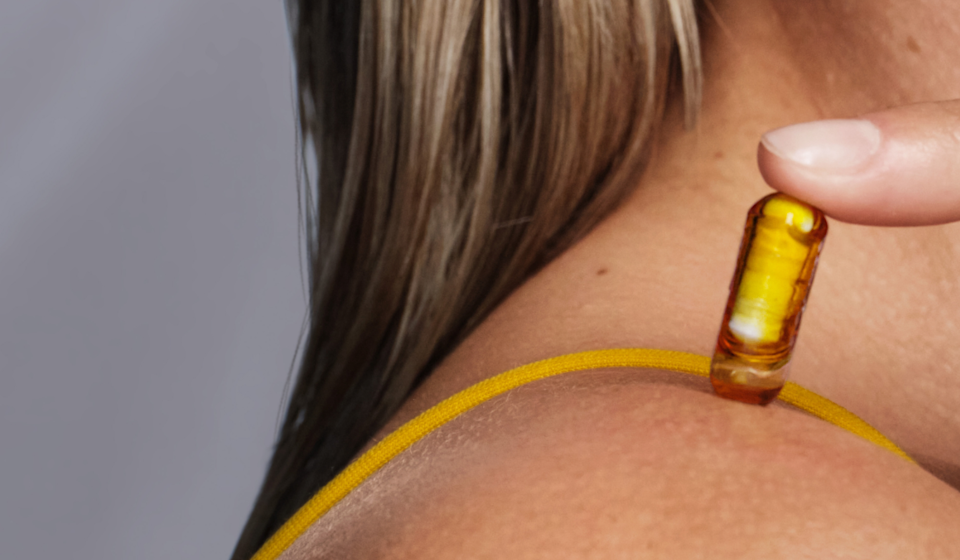So, What Is Premature Aging?
Chronological skin aging is a natural process of the skin changing as you age. It’s often defined in scientific literature as intrinsic and extrinsic. Intrinsic skin aging is due to the passage of time, and likely influenced by your genetic makeup. Extrinsic aging is something we can potentially influence and what we’re talking about when referring to premature aging of the skin. (2)
It’s likely caused by something called photoaging, the exposure to sunlight and UV rays. (2) Extrinsic skin aging can also be a byproduct of diet, exposure to pollution, smoking habits, and overall quality of life. (3) It accelerates the skin aging process and may be the reason you’re seeing things like fine lines, wrinkles, brown spots, or other skin pigmentation changes. Photoaging is responsible for 90% of visible changes you’ll notice to your skin as you get older. (4)
What Causes Changes In Skin Appearance?
A number of factors influence your skin’s health, and some can accelerate the visible signs of aging. Let’s take a look at what may cause changes in our skin earlier than we expected.
• Genetic makeup: if someone has light-colored skin and light eyes, changes in their skin might appear earlier than in their friend of the same age who has darker skin. (1)
• Sun exposure: Exposure to ultraviolet (UV) rays is the most common cause of premature aging.
• Tobacco use: Smoking leads to a loss of skin elasticity that results in the grayish tan of the skin as well as faster skin aging.
Pollution: Air pollution can lead to skin aging and inflammation of the tissue. (5)
• Stress: When stressed, our body releases cortisol, a hormone that increases oil production in our skin. This excess oil can clog pores and lead to skin blemishes. Not to mention, when we’re feeling overwhelmed we tend to neglect our skincare routine.
• Weather: Cold air that causes dry, itchy skin can make wrinkles and fine lines appear more noticeable. (6)
• Dehydration: If your water-guzzling routine has been waning, it could show up on your skin. Healthy skin is hydrated skin. That can be done by drinking water and taking HyaCera™ daily to enhance your skincare routine from the inside out. HyCera can support the reduced appearance of wrinkles and fine lines while promoting hydrated skin.* (7)
• Nutrient deficiencies: While skin ages naturally, poor nutrition, lacking in antioxidants and essential nutrients, can accelerate this process by hindering the body's ability to support and maintain a healthy skin barrier. (16)
• Your lifestyle: Life can throw us curve balls sometimes - a demanding new job, a shift in routine, a change in a relationship, or an ongoing health journey. Remember, while these experiences can impact how we feel and look, they're also part of our story. (9)
Can You Prevent Premature Aging?
Let's face it, aging is a natural part of life. But that doesn't mean there isn’t anything we can do to support our skin.
Here are 7 strategies for healthy aging of our skin:
1. Protect your skin from sun exposure: One of the most important things you can do to help with premature aging of the skin is to watch your exposure to UV. We’re not saying to hide away in a dark cellar for the rest of your days, just remember to wear broad spectrum sunscreen with SPF 30 or higher every day, even on cloudy days. If you can wear a hat and UV-blocking clothes to prevent harmful rays from permeating the skin, even better. (11)
2. Taking a skincare supplement: Incorporate HyaCera™ to help reduce wrinkles, fine lines, and crow’s feet. It combines two clinically-studied ingredients, Ceratiq® and Hyabest®. Ceratiq® supports the reduced appearance of wrinkles and fine lines and promotes hydrated skin on the face and body. Hyabest® can help promote glowing and moisturized skin.*
3. Eat a healthy diet: Limit refined carbohydrates and sugar since those may contribute to signs of premature aging. Pack in fruits and vegetables, whole grains, and lean protein. (12)
4. Reduce alcohol consumption: Alcohol plays a role in your skin’s appearance and can make it look older.
5. Rest up: A poor night’s sleep takes a toll on how your skin looks the next day. Shorting yourself sleep or not getting quality sleep can speed up cell aging. (13)
6. Quit smoking: Smokers who quit often report that their skin looks better. (14)
7. Add in resistance training: Aerobic exercise can improve skin elasticity and upper dermal structure. Resistance training did that and improved the skin thickness at the end of a study that showed exercise’s impact on skin aging. (15)










